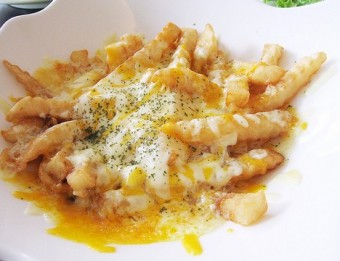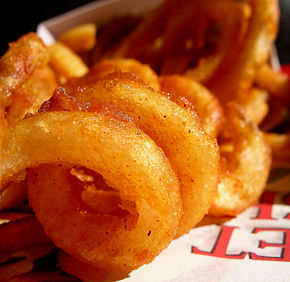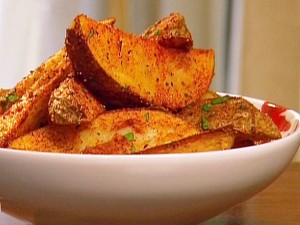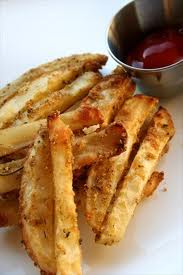
Exactly who introduced these golden strips of goodness to the world isn’t entirely known. Among the various theories, it’s generally accepted that the French fry was invented by either the Belgians or the French.
Potatoes were first introduced to Europe not through the French or Belgians, but through the Spanish. In 1537, Jimenez de Quesada and his Spanish forces encountered a village in Colombia where all the natives had fled. Among other things, they found in the native’s food stuffs potatoes, which the Spanish initially called “truffles”.
Around 20 years later, potatoes were brought back to Spain and also introduced to Italy. At this time, the potatoes were still quite small and bitter and didn’t grow well in either Spain or Italy. However, over time, larger and less bitter versions of the plant were cultivated and the plant gradually caught on elsewhere in Europe, though it was initially met with quite a bit of resistance (for more on that, see the bonus facts at the bottom).
In any event, historical accounts indicate that the Belgians were possibly frying up thin strips of potatoes as early as the late 17th century (though some claim it wasn’t until the late 18th century) in the Meuse Valley between Dinant and Liège, in Belgium. How they supposedly came up with the idea was that, in this area, it was very common for the people to fry up small fish as a staple for their meals. However, when the rivers froze up thick enough, it tended to make it somewhat difficult to get fish. So instead of frying up fish in these times, they would cut up potatoes in long thin slices, and fry them up as they did the fish.
Giving some credence to this story is that the Spanish controlled much of what is now modern day Belgium at the time the Spanish introduced the potato to Europe. So, at least, the Belgians probably were among the first to have a crack at the potato, in terms of thinking up ways to prepare food from potatoes.
 Now
to the French argument: the popularity of the potato in France is
largely credited to a French army medical officer named
Antoine-Augustine Parmentier, who very famously championed the potato
throughout France and parts of Europe. During the Seven Years War,
Parmentier was taken captive and, as a part of his prison rations, was
given potatoes.
Now
to the French argument: the popularity of the potato in France is
largely credited to a French army medical officer named
Antoine-Augustine Parmentier, who very famously championed the potato
throughout France and parts of Europe. During the Seven Years War,
Parmentier was taken captive and, as a part of his prison rations, was
given potatoes.At this time, the French had previously used potatoes only for hog feed and never ate them. The reason being that they thought potatoes caused various diseases. In fact, in 1748, the French Parliament even banned cultivation of potatoes as they were convinced potatoes caused leprosy. However, while in prison in Prussia, Parmentier was forced to cultivate and eat potatoes and found the French notions about the potato just weren’t true.
When he came back to France, Parmentier began championing the potato as a potential food source. Finally, in 1772, the Paris Faculty of Medicine proclaimed that potatoes were edible for humans, though Parmentier still encountered significant resistance and wasn’t even allowed to grow potatoes in his garden at the Invalides hospital where he worked as a pharmacist.
Parmentier then began a more aggressive campaign to promote the potato in France, hosting dinners featuring potatoes with such notable dignitaries as Benjamin Franklin, Antoine Lavoisier, King Louis XVI, and Queen Marie Antoinette. He also would hire armed guards to surround his potato patch, to try to convince people that what was in the patch was very valuable. He would then tell the guards to accept any bribes they were offered by people and let them “steal” the potatoes. In the end though, it took a famine in 1785 for the potato to become popular in France.
Once the French accepted the potato though, its popularity skyrocketed in France. By 1795, potatoes were being grown on a very large scale in France, including at the royal gardens at Tuileries, where the gardens were converted into potato fields. Within that span of time, the French either invented or learned to make fries. Once discovered/invented French fries became extremely popular in France, particularly in Paris, where they were sold by push-cart vendors on the streets and called “frites”.
Now, it should be noted that this all happened in the late 18th century, which was as much as 100 years after some people say the Belgians were supposedly already making “French” fries. But by other arguments, this all happened around the same time for both the French and the Belgians. So who knows?
It should also be noted that, shortly before the potato became popular in France, the Franco-Austrian war was going on (also known as the War of Austrian Succession), much of which took place around modern day Belgium. So it’s possible that the French soldiers were introduced to fries by the Belgians at this time and, a couple decades later when the potato became popular in France, these former soldiers then introduced the preparation method to the rest of France. Or it’s possible the French came up with the idea on their own and spread them to Belgium around the same time; or that both came up with the idea independently.
 Whatever
the case, it was the French who seem to be the ones that spread fries
to America and Britain and it, in turn, was the Americans, through fast
food chains, that eventually popularly introduced them to the rest of
the non-European world as “French fries”. Ironically, because of this
latter spread by American fast food chains, in many parts of the
non-European world, “French fries” are more often than not known as
“American fries”.
Whatever
the case, it was the French who seem to be the ones that spread fries
to America and Britain and it, in turn, was the Americans, through fast
food chains, that eventually popularly introduced them to the rest of
the non-European world as “French fries”. Ironically, because of this
latter spread by American fast food chains, in many parts of the
non-European world, “French fries” are more often than not known as
“American fries”.Bonus Facts:
- While the Belgians may or may not have invented the French fry, today, they do consume the most French fries per capita of any country in Europe.
- In most of the English speaking world, thin cut and thick cut fries are called two different things, fries and chips, respectively. In North America, it is typical to simply call them all French fries and, when they are distinguished, it is usually just by adding an adjective, rather than using a completely different word: i.e. steak fries (chips), French fries, curly fries, etc.
- In 1802, Thomas Jefferson had the White House chef, Frenchman Honoré Julien, prepare “potatoes served in the French manner” for a dinner party. He described these as “Potatoes deep-fried while raw, in small cuttings”. (French fries at a White House state dinner…. classy.) This is one of the earliest references to fried potato strips being referred to as “French”.
- Steak fries, or chips, actually tend to have lower fat content than normal French fries, due to the lower surface to volume ratio.
- Burger King’s French fries (and probably McDonald’s too) are sprayed with a sugar solution just before being packaged and shipped to the various franchise locations. This produces the golden color through caramelization of the sugar when it is fried. Without this, the fries would end up having about the same outside color as inside after being fried.
- McDonalds is known to fry their fries twice, the combined time taking about 15 to 20 minutes. Once for cooking the insides and once for making them extra crispy on the outside.
- Popular condiments to dip French fries in varies quite a bit from country to country. In America, ketchup is typically the dip of choice for French fries. In certain parts of Europe, mayonnaise is king. The British tend to favor malt vinegar for dipping their fries. The French themselves tend to just eat the fries straight as often as not. I personally prefer Ranch or Blue Cheese dressing with highly salted French fries.
- Belgians, who are the world’s connoisseurs when it comes to French fries, occasionally will serve French fries with egg as a topping. The raw egg is cracked over the French fries immediately after the fries have been pulled from the fryer. This tends to mostly cook the egg, but leaves the yoke somewhat runny for dipping the fries in.
- Cultivation of potatoes is thought to have started around the same time as the start of the Common Era, around 2000 years ago in Peru and Bolivia. It gradually spread from there throughout South America. These early forms of the plant were fairly bitter and tuber-like.
- The word “potato” comes from the Haitian word “batata”, which was their name for a sweet potato. This later came to Spanish as “patata” and eventually into English as “potato”.
- The slang term for potato, “spud”, comes from the spade-like tool that is used to harvest the potatoes.
- When the potato was first introduced to Ireland and Scotland, it was met with quite a bit of resistance from Protestants there, due to the fact that the potato wasn’t mention anywhere in the Bible; thus, it wasn’t clear whether it was acceptable to eat, so they refused to plant them at first. The Catholics, on the other hand, chose to sprinkle them with holy water before planting, thus making them acceptable to plant and eat.
- Potatoes also met with resistance when first introduced to Europe as a whole, due to the fact that the Europeans were convinced potatoes caused a variety of diseases and were also thought to be poisonous. Tomatoes also were thought to be poisonous by many, when first introduced to Europe from the new world.
- Parmentier not only championed the potato, but he also was responsible for the first mandatory smallpox vaccination in France in 1805, when he was the Inspector-General of the Health Service under Napoleon.
- Parmentier was also the one who invented the French dish, Hachis Parmentier, a variation of which is also sometimes called “Shepperd’s Pie”. Hachis Parmentier is basically ground beef topped with mashed potatoes and cheese. Variations on this dish include adding gravy, corn, or other vegetables.
- In addition to the above, Parmentier also founded a school of bread making; was a pioneer in methods for extracting sugar from sugar beets; and heavily researched food preservation methods, including refrigeration.
 During
the 19th century, Ireland was almost completely dependent on the potato
as the primary food source for most of its citizens. This lead to the
catastrophic potato famine of the 1840s when a certain strain of fungus
almost completely wiped out the potato in Ireland.
During
the 19th century, Ireland was almost completely dependent on the potato
as the primary food source for most of its citizens. This lead to the
catastrophic potato famine of the 1840s when a certain strain of fungus
almost completely wiped out the potato in Ireland.- “To French”, in cooking, now commonly refers to cutting any food into long thin strips. The origins of this phrase comes from the late 19th century, so well after the term “French fried potato” was common.
- The French term “frite”, for fries, indicates deep frying, whereas, in English, “fried” could mean deep frying, sautéing, or pan-frying. Probably for this reason, “French fried”, has come to mean “deep-fried” in English, regardless of what is being fried.
- According to many of the “Belgian origin” supporters, French fries are called French fries because, during WWI, American soldiers were introduced to fries by the Belgians. At the time, the Belgian Army spoke French. The fries were called “Les frites” (which is French) by the Belgians and so the American soldiers took to calling them “French fries”. This theory is incorrect, for a couple of reasons. First, as mentioned, in the 1800s, Thomas Jefferson referred to fried potato strips as “frying potatoes in the French manner”. In addition to this, there is an American cookbook from the 1850s that specifically uses the term “French Fried Potatoes” to describe French fries; there are also numerous other references to “French Fried Potatoes” from the 1850s on, in the United States; these all obviously pre-date WWI.
- Between the 1850s and 1930s, French fries were known more illustratively as “French fried potatoes” in America. Around the 1930s, everybody dropped the “potatoes” on the end and just called them French fries.
No comments:
Post a Comment